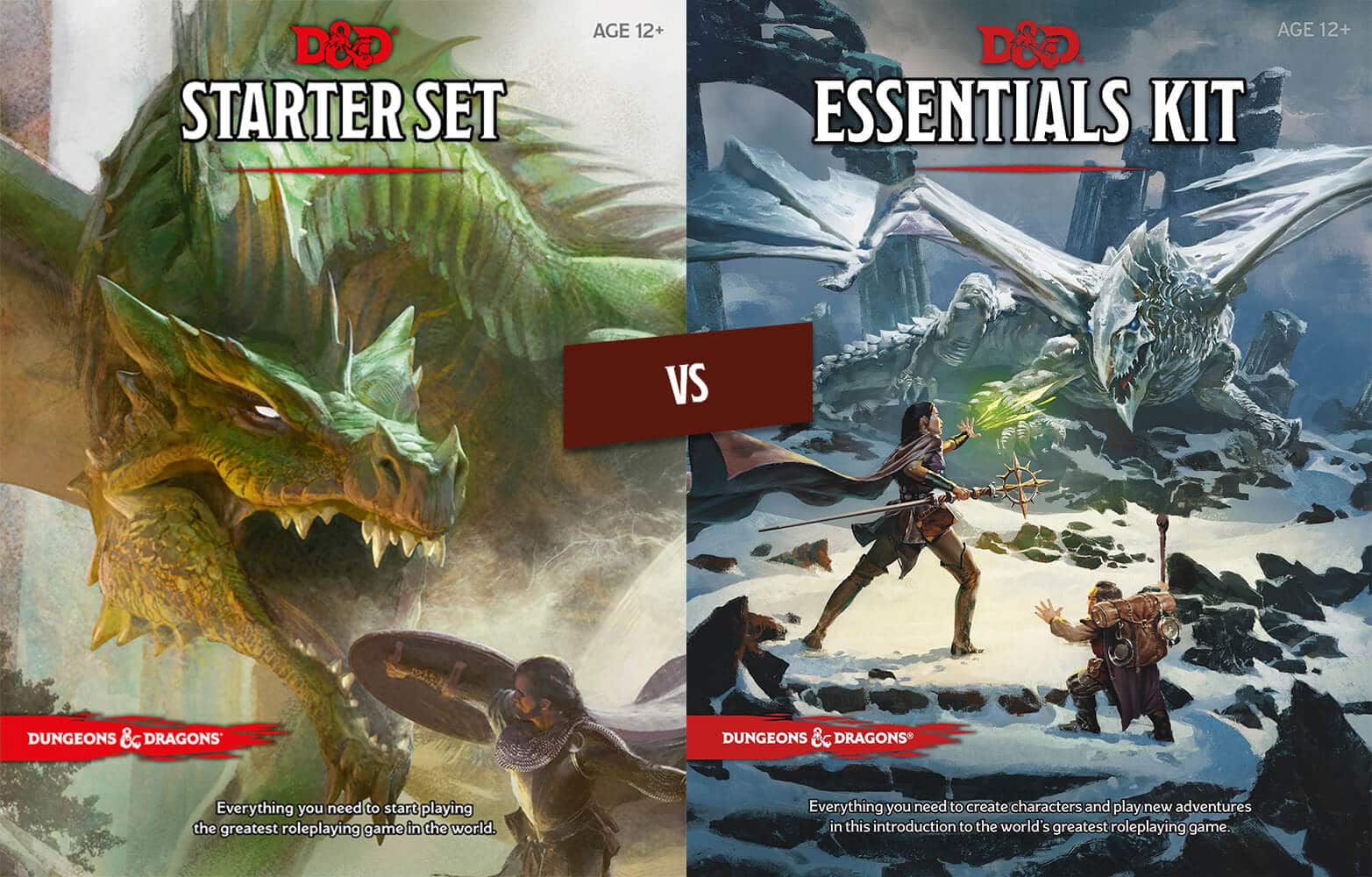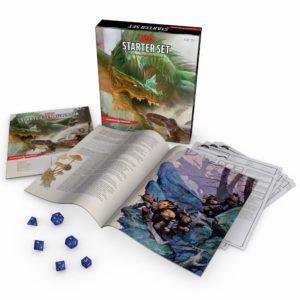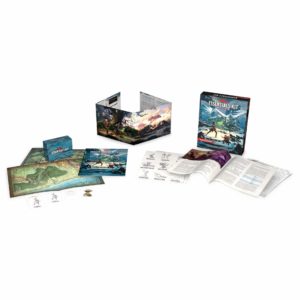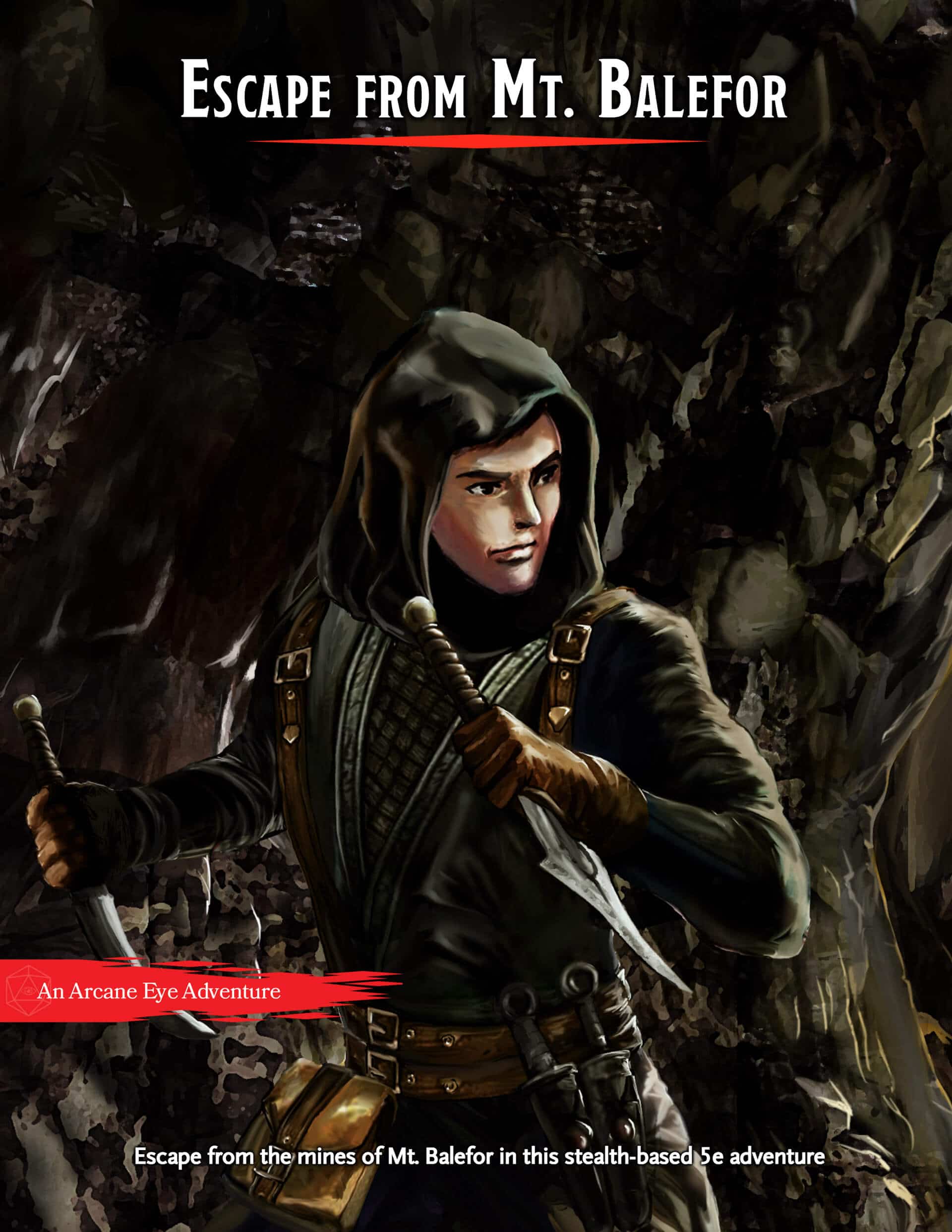D&D Starter Set vs. Essentials Kit
Published on February 10, 2021, Last modified on May 7th, 2021
The D&D Starter Set and Essentials Kit are a bit different from the other books released by Wizards of the Coast. In this article, we do a deep dive into what’s included, if they’re worth it, and which one to buy.

Table of Contents
What they include:

Starter Set |

Essentials Kit |
The Starter Set is meant as an introduction to the world of Dungeons & Dragons. It is geared towards complete beginners of the TTRPG genre. It includes:
|
The Essentials Kit is meant to provide new D&D players with everything they need to run a long-term campaign. It includes:
|
Pros:
|
|
Cons:
|
|
The best adventure for D&D beginners
Starter Set – Winner
The Starter Set includes Lost Mine of Phandelver (LMoP). LMoP is one of the most well-received 5e adventures to date and is very well structured for beginning DMs and players. While the module is intended to serve as a basic introduction to tabletop D&D, it manages to get a lot of things right in the pacing and structure of the adventure.
The adventure takes place in a fairly small, unspecified geographic area of the Forgotten Realms, but can easily fit into any high fantasy setting.
Pros:
- Lost Mine of Phandelver is a great start to any D&D campaign. It is meant to serve as a jumping-off point for DMs to either start their own adventure after completion or jump into another module that starts at 5th-level such as Storm King’s Thunder.
- The module features well-crafted combat scenarios, a dungeon crawl or two, and a town that isn’t too large, which all serve as awesome tools to get your party accustomed to the world of D&D.
Cons:
- The first chapter of the adventure is extremely swingy for 1st-level players. Either your players will tear throw the goblin encounters, or they can be easily killed because of their measly hitpoints.
- The villain isn’t particularly compelling. However, with enough effort, you can spin that he’s more of a henchman to a bigger evil. When the players complete the adventure they can ride off to their next quest.
Essentials Kit
Dragons of Icespire Peak (DoIP) is the adventure included in the Essentials Kit. While it takes place in the same general location as LMoP, the story’s structure and pacing aren’t as well-received as its predecessor.
The adventure revolves around a young white dragon that has taken up roost in a location around Phandelver. The players begin their story in the town of Phandelver, where they are expected to set out completing quests off of a job board. Once the jobs are done, a couple of side quests open up to give players a chance to level up further.
None of these sidequests explicitly lead the party to Icespire Hold, the location of the young white dragon, but there are options to help guide your party towards the dragon when they are ready to fight it.
Pros:
- While hard to loop into the story, the job board provides short, well-structured one-session adventures.
- There is plenty of player agency and non-linear storytelling.
Cons:
- 1st level characters are extremely easy to kill by accident. This module pits 1st level characters against some pretty nasty foes including a CR 3 Manticore.
- The beginning of the campaign has a weak plot hook that newer DMs might struggle with.
- There is no definitive, overarching plot that brings the party to the white dragon’s lair.
How do the rulebooks differ?
Each kit comes with a pared-down rulebook that provides a streamlined set of rules for DMs to run the game. Keep in mind, these rulebooks are not the same as the Basic Rules or the Dungeon Master’s Guide, both of which provide a much more in-depth look at the rules and tools available for officiating a game of D&D.
For all intents and purposes, each kit’s rulebook is the same at its core, but let’s examine the differences
Starter Set – Winner
The Starter Set rulebook is 32-pages, half the size of the Essentials Kit, but in this case bigger may not always be better. The Starter Set rulebook is very streamlined when it comes to teaching new DMs how to play the game. After just reading the first 16 pages, any DM will be ready to run their first game.
Because the Starter Set provides pre-generated character sheets, its rulebook is able to skip any rules around character creation and get right into the basics of adventuring, exploration, and combat. For the intent of learning the game, there is no better document than the Starter Set Rulebook. However, if you already have a grasp of the basic rules, this document will not provide much value.
Essentials Kit
The Essentials Kit rulebook is double the page count of the Starter Set but definitely doesn’t provide double the value. Chapters 2,3 and 4 of this rulebook (Playing the Game, Equipment, and Spells, respectively), are essentially the same as what is provided in the Starter Set rulebook.
The biggest difference between the two rulebooks is that the Essentials Kit has 27 pages of rules for character creation. This allows your players to choose their race (Dwarf, Elf, Halfing, or Human), class (Bard, Cleric, Fighter, Rogue, or Wizard), and background (Acolyte, Criminal, Entertainer, Sage, or Soldier).
While this isn’t the full range of options provided in the Player’s Handbook, this provides players the ability to customize their character all the way up to 6th-level. This is in contrast to the Starter Set which provides a set track that takes players from 1st to 5th level.
The Essentials Kit also provides a couple of pages of magic items that players can find, as well as a mechanic for running sidekicks in D&D 5e.
Value for money
Starter Set
The Starter Set serves as a great introduction to the world of D&D but doesn’t provide much value beyond the initial adventure. As soon as you hit 5th level, you will need to turn to either the Basic Rules, the Player’s Handbook, or D&D Beyond to find more content for your party’s characters. You will also need to look for where to turn next in terms of continuing the adventure. For more information on this check out the What’s Next section of this article.
Essentials Kit – Winner
The Essentials Kit manages to edge the Starter Set out here. For around the same cost, the Essentials Kit provides slightly more value for your money spent because:
- The rulebook contains rules for creating player characters, so you could start another 1st-level adventure after finishing Dragon of Icespire Peak and be able to roll entirely new characters.
- The rulebook is of better quality than the Starter Set’s because it has a bound spine, rather than stapled.
- The accessories can come in use in later sessions. In order of value, these accessories are the DM’s screen, magic item cards, and the poster map.
- The one-page adventures provided in this book serve as an excellent template for creating your own adventures or can be used in other campaigns if they weren’t completed while playing through this module.
- The kit includes 50% off the Player’s Handbook on D&D Beyond, which saves $15 on a very important $30 book.
- More dice are provided than the Starter Set, but you will still probably need to buy more if you want to play in-person.
Who wins, the Starter Set or Essentials Kit?
As you can probably tell from reading this article, there isn’t a clear “best” introductory kit. Based on what you need out of an introductory kit, you will now be able to make an informed decision between the two:
Buy the Starter Set if…
- You and your table are complete beginners to D&D.
- You are looking to dip your toe into the waters of TTRPGs before investing too heavily with time, money, and brainpower.
- You want a bit more guidance when it comes to reading the rules of D&D and planning an adventure.
Buy the Essentials Kit if…
- You and your table are intermediate board game or RPG players.
- You want the ability to make the story your own and your players want more customization options for their characters.
- You plan on playing D&D past the introductory adventure.
- You aren’t afraid of adjusting a story to make it more appealing for your players.
What’s next after the introductory kits?
These kits are great for beginning your journey into the realm of D&D and TTRPGs Here’s where to venture next after you have completed, or would like to move on from the introductory adventures:
Homebrew
Homebrew is where the DM creates their own adventure. While you can pull inspiration from other sources, you create the story that the characters play through. A lot of DMs find this to be the most time consuming, but also the most creatively satisfying way to run adventures.
1st Party Sources
Wizards of the Coast has a ton of high quality, prewritten adventures that can start at 5th level. You can read all about the official 5e adventures here.
3rd Party Sources
There are plenty of creators that have taken it upon themselves to create adventures for others to play. The official source for finding these adventures, and lots of other homebrewed content, is DMs Guild. Arcane Eye also has published an adventure or two, if you enjoy our content, you can check them out at the Arcane Eye shop!
Other Games
Maybe you liked D&D and want to see what else is out there or perhaps you didn’t love it and want to try something else out, that’s okay! Our article, Tabletop Games To Play If You Like D&D, covers some other games to check out to continue your foray into the tabletop space. If video games are more your speed, check out some of our favorite video games for fans of D&D.
Conclusion
We hope you’ve liked our comparison review of the D&D Starter Set and Essentials Kit! If you would like any other products reviewed in-depth, feel free to leave a comment below!
